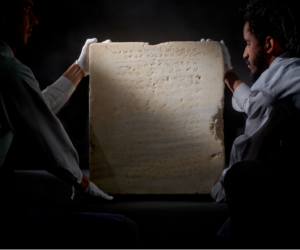
Imagine stumbling across something at home that’s worth a fortune…
An old painting, a vintage necklace, a slab of marble sitting outside.
Well, in the true story you’re about to read, that’s exactly what happened.
A used tablet — in fact, a very used tablet — was recently discovered.
And it just sold at auction for $5.04 million.
Today I’ll explain what’s going on here.
Then I’ll reveal how you can get in on the action.
A Slab of Marble — Or Something More?
This story gets its start way back in 1913, when a new railroad was being built from Israel to Egypt.
During the excavation for the railroad, an Arab man found a slab of white marble approximately two feet high and two inches thick.
Although it weighed about 115 pounds, he managed to drag it home. For the next thirty years, he used it a paving stone in his home’s inner courtyard.
In 1943, the man’s son dusted off the stone and saw it was engraved. It didn’t take long for him to figure out this was no ordinary slab of marble.
As it turned out, this was an historic tablet — The Ten Commandments.
The Ten Commandments
The Ten Commandments are one of the most widely known texts in world.
As described in their earliest recordings, they were spoken directly by God to Moses so they could be conveyed to the Israelites encamped at Mount Sinai after the Exodus from Egypt.
They remain fundamental today to adherents of Judaism and Christianity. They also have relevance outside of religion, as they underpin the human experience as it relates to personal conduct and the social compact.
The particular tablet that was found is an historic discovery.
Dating to the late Roman-Byzantine era (ca. 300–800 CE), it’s approximately 1,500 years old. It’s the only complete tablet of the Ten Commandments that survives from this era.
Here’s a photograph of it, courtesy of Sotheby’s auction house:

THE TEXT OF THE TABLET
As translated from Hebrew, here’s a line-by-line inscription of its twenty lines of text:
- Dedicated in the name of Korach
- I will call you to remember for goodness forever
- God spoke
- all these words
- saying I am the Lord
- your God you shall not have
- for yourself other Gods
- besides me; you shall not make
- for yourself a sculptured image or any likeness;
- for I the Lord
- your God am an impassioned God;
- Remember the Sabbath day
- keep it holy; honor
- your father and your mother;
- you shall not murder; you shall not commit adultery;
- you shall not steal; you shall not bear [false witness] against your neighbor
- you shall not covet; you shall erect
- these stones that
- I am commanding you today
- on Mount Gerizim rise up to God
From 0 to $5.04 Million
Since being hailed as an historic discovery, the tablet has changed hands a few times.
In 1943, it was sold by the Arab man’s son to Jacob Kaplan, an Israeli scholar.
In 1995, it was sold by Kaplan’s descendants to an antiquities dealer named Robert Deutsch, who in turn sold it to the founder of the Living Torah Museum in Brooklyn, New York.
In 2016, it was purchased for $850,000 by the Judaica collector Dr. Mitchell Stuart Cappell.
Then, last month, the auction house Sotheby’s put it up for sale, estimating that it would sell for between $1 million and $2 million.
Instead, an anonymous buyer paid a whopping $5.04 million.
As Richard Austin, Sotheby’s global head of books and manuscripts, said in a statement: “The result reflects the unparalleled importance of this artifact. To stand before this tablet is an experience unlike any other — it offers a direct connection to the shared roots of faith and culture that continue to shape our world today.”
“An experience unlike any other”? “A direct connection to the shared roots of faith and culture that continue to shape our world today”?
You sure don’t get that type of experience or connection with stocks or bonds!
And that’s just one of the factors that makes investments in such antiquities so compelling…
An Alternative to Stocks and Bonds
As I've written recently (for example, here and here), there are many good reasons to invest in “alternative” assets like art, wine, and collectibles like antiquities.
These reasons include diversification, a hedge against inflation, and, of course, the potential for higher returns.
Most of us can’t afford to spend $5 million on such investments.
But if you could afford $100 instead, check this out:
Recently, a new type of website has emerged to give ordinary people the ability to invest small amounts of money into collectibles.
Essentially, just like you can buy a $100 stake in a startup, now you can buy $100 worth of a vintage bottle of wine, a classic work of art, or a piece of antiquity.
One such website is called Public, where you’ll find collectibles ranging from rare sneakers to investment-grade art and antiques.
Another site called Rally features everything from rare whiskeys to cars.
Before You Dive in
Just keep in mind that all the typical caveats about investing apply here.
For example, don’t invest more than you can afford to lose, and be sure to dip your toe into the water before diving in.
Furthermore, many of these investments aren’t “liquid.” That means they can’t necessarily be converted into cash at the snap of your fingers.
So please don’t invest your rent or grocery money into these offerings.
But if you’re looking to invest in collectibles — or find “a direct connection to the shared roots of faith and culture that continue to shape our world today” — they could be a worthwhile place to start.
Happy investing!
Best Regards,

Founder
Crowdability.com

